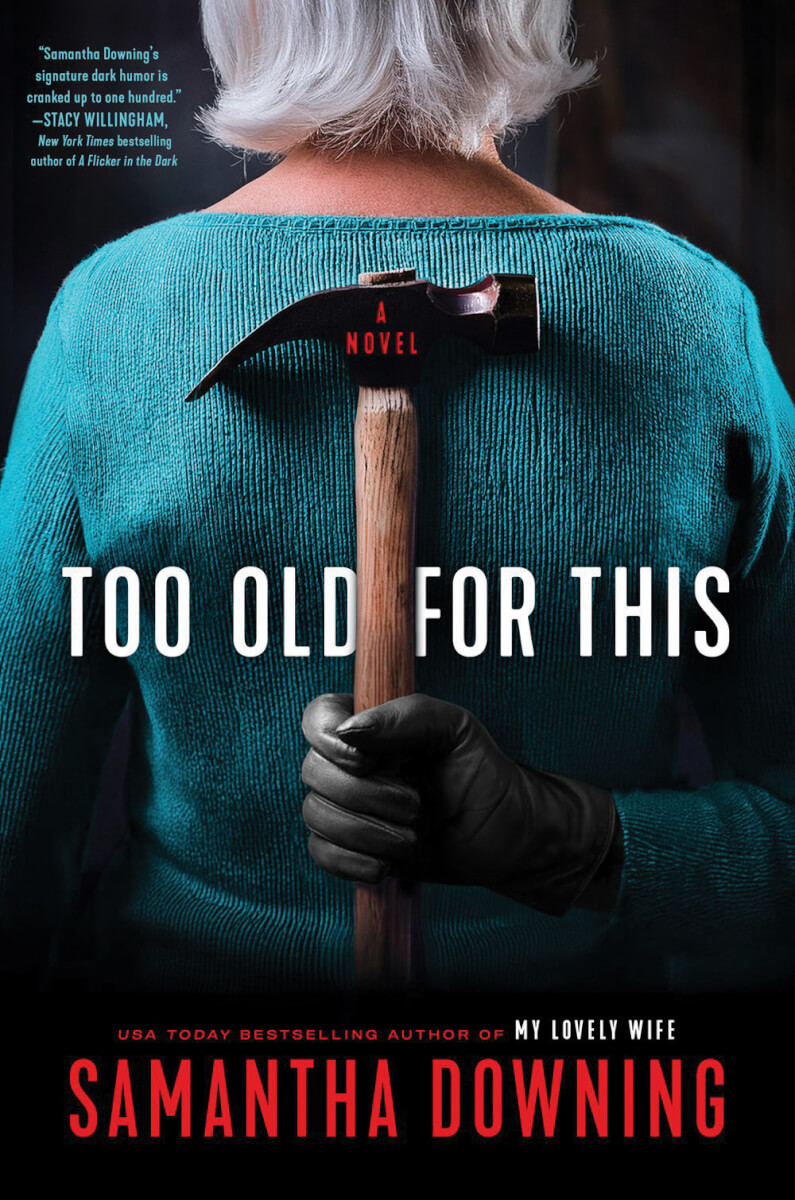Too Old for This
Samantha Downing’s latest thriller, Too Old for This, introduces septuagenarian Lottie Lansdale, a long-retired serial killer returning for an encore performance. Or two. Or more. These encores are borderline unintentional. Lottie would like nothing better than to live out the remainder of her assumed-identity days in small-town anonymity; the high point of Lottie “Jones” ’ week is a church bingo game. But it seems as if circumstances will conspire to deny her that option. To begin with, an investigative filmmaker uncovers Lottie’s new identity and approaches her about making an in-depth documentary of her death-dealing past, and that of course cannot be allowed. So, OK, one last killing, to take that threat off the table. But then the filmmaker’s boyfriend comes nosing around, asking uncomfortable questions about the disappearance of his loved one, and, well, you can see this coming, right? To Lottie’s great credit, she demonstrates a wickedly dark sense of humor and endears herself to the reader despite (or perhaps because of) her proclivity for graphic violence. Author Downing displays an equally dark sense of humor as she details the difficulties of being an analog serial killer presented with the digital realities of murder in the 21st century: security cameras, cellphone tracking apps and the like. Too Old for This is a clever and entertaining standalone thriller (unless, of course, Lottie, newly emboldened, decides one day to pick up where she left off. . . .)
There Will Be Bodies
Lindsey Davis’ latest historical mystery, There Will Be Bodies, removes Flavia Albia from her familiar digs (Ancient Rome) to literal digs: unearthing a once-lovely home buried in the eruption of Mount Vesuvius, the very eruption that put the word “Pompeii” into the popular vernacular. There will indeed be bodies, among them the bodies of three enslaved people, imprisoned and in chains, left to die beneath the ash and lava. To all appearances, this must be deliberate murder. Then there is the matter of the house’s owner, who remains missing like many others in the wake of the eruption. Some have not yet been uncovered in the rubble, some are missing by their own design and some have vanished courtesy of diabolical intervention by an enemy or enemies. Medium-high society protagonist Flavia is her usual outspoken self, insightful and droll, entertainingly manipulative and dogged in pursuit of justice. As is the case with earlier entries in the series (this one is number 13), the reader is required to suspend a certain amount of skepticism regarding the existence of a female private investigator in what was one of the most patriarchal societies in history. But this is remarkably easier than it sounds, as Flavia is so genuinely likable and quite adept at her profession.
★ The Witch’s Orchard
Cold cases don’t come much colder than Molly Andrews, one of three girls who vanished from a small Appalachian town more than a decade ago. She was only 4 years old at the time. Despite a yearlong FBI investigation and the subsequent involvement of a private detective, there has not been so much as a whisper of Molly’s whereabouts. The only clues of any import are the applehead dolls, a local folk craft, left in the place of each of the missing girls. That’s the setup for Archer Sullivan’s The Witch’s Orchard and the entry point of current-day investigator Annie Gore. Annie’s more than a bit reluctant to dive into such a cold case, but she’s also rather desperately in need of the $800-per-day payment her client—Molly’s brother—has offered. She plans to give the case a week, but it does not take nearly that long for her to shove the proverbial stick into the proverbial hornet’s nest. Annie manages to alienate the local sheriff almost immediately, followed in rapid succession by several townsfolk. But she seems to be getting some results, especially after someone takes a potshot at her with a sniper rifle. The suspect list is longish: the pastor with a very un-pastorlike secret; his uber-religious wife; the aforementioned sheriff who apparently seeks to stymie Annie’s investigation at every opportunity; the wealthy and reclusive widow; the tarot-reading “witch” who is revered, feared and laughed at in equal measure. The narrative is linear, relatable and revealing, with no pyrotechnics or intricate plot devices. And the ending, just—wow! I did not see that coming at all.
★ The Diary of Lies
Philip Miller’s The Diary of Lies opens in chaotic fashion: shifting between viewpoints, locales, subject matter and timelines tectonically, abruptly and seemingly randomly. The good news is that the initial bedlam is necessary, and it sorts itself out fairly quickly in the ensuing narrative. Freelance investigative journalist Shona Sandison, fresh off an awards ceremony in her honor, gets recruited to cover what may be the biggest story of her career. The code name of her subject is “Grendel,” presumably a reference to the monster in the epic poem Beowulf. Sandison does not know the nature of Grendel—a person, a consortium, a program?—but she discovers in short order that Grendel is life-threatening to those who delve too deeply into its secrets. With a contract killer in hot pursuit, Sandison must decode the contents of an encrypted drive. She receives assistance from unexpected quarters: a minor government official inadvertently looped in on a top-secret group chat (Sound familiar?); a survivalist hacker imminently bound for distant shores; and even a rude (but funny) porn shop clerk. Not a spoiler alert: Grendel, whoever or whatever it may be, turns out to be capable of disastrously upending the social order of a major nation, without prior notice or any effective constraints. The Diary of Lies is deeply scary and all too believable.
